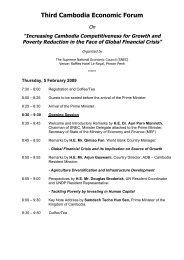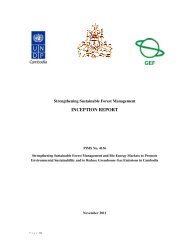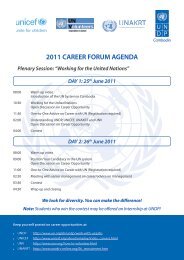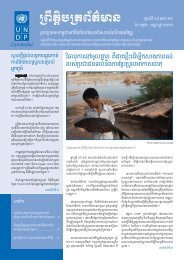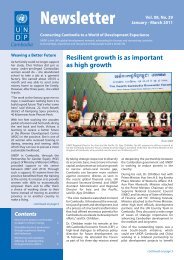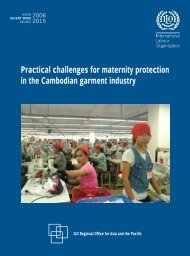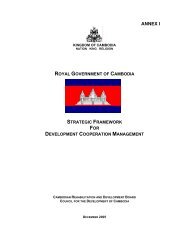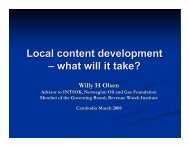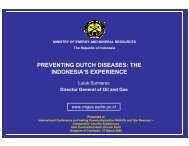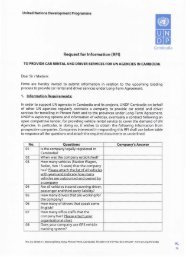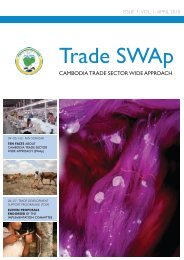UN Analysis Final.pdf - United Nations in Cambodia
UN Analysis Final.pdf - United Nations in Cambodia
UN Analysis Final.pdf - United Nations in Cambodia
You also want an ePaper? Increase the reach of your titles
YUMPU automatically turns print PDFs into web optimized ePapers that Google loves.
• Personal <strong>in</strong>troductions (names)<br />
• Information about the study<br />
• Objectives, and how the study results may be used<br />
• Study process (FGDs and <strong>in</strong>terviews, commune discussions)<br />
• Duration<br />
• Make it clear that no immediate benefits/projects will come to the village or any <strong>in</strong>dividuals as a<br />
result of this study.<br />
It is important to be transparent about the study, and provide any <strong>in</strong>formation that the community may<br />
want to know. It is also important that no false expectations are generated <strong>in</strong> this process.<br />
FGDs The FGDs should ideally have between 8-12/15 participants. Each group will generally last 2 to<br />
2.5 hours. The facilitators should <strong>in</strong>form participants about the expected duration of the discussion<br />
before start<strong>in</strong>g and make sure they understand and agree. If the meet<strong>in</strong>g is go<strong>in</strong>g to exceed 2.5 hours,<br />
be sure to stop and clarify with participants how much longer the meet<strong>in</strong>g may go on. Participation <strong>in</strong><br />
the FGD is strictly voluntary, and participants may leave at any time. It is important to ensure everyone’s<br />
responses will be kept strictly confidential, and that there will be no attribution accord<strong>in</strong>g to name.<br />
The FGDs will be recorded with a small discrete cassette recorder <strong>in</strong> order to support documentation<br />
and analysis. Participants should be <strong>in</strong>formed of this <strong>in</strong> the beg<strong>in</strong>n<strong>in</strong>g and asked permission to record,<br />
ensur<strong>in</strong>g people that their names will be not be associated with the record<strong>in</strong>g.<br />
Previous FGD experience shows that male participants tend to dom<strong>in</strong>ate mixed group FGDs, which<br />
dim<strong>in</strong>ishes women’s voices and perspectives. Also, women are often reluctant to raise sensitive issues<br />
(e.g., reproductive health) <strong>in</strong> mixed groups, or groups with a male facilitator. As a result, the FGD<br />
facilitators and note-takers will be the same sex as the FGD participants. For example, for any female FGD,<br />
the facilitators and note-takers must be female.<br />
After <strong>in</strong>troduc<strong>in</strong>g yourselves and expla<strong>in</strong><strong>in</strong>g the purpose of the research, the facilitators should start each<br />
FGD with a community time-l<strong>in</strong>e exercise to help participants reflect about how circumstances have been<br />
chang<strong>in</strong>g <strong>in</strong> their village. The time-l<strong>in</strong>e exercise should focus on important events, such as development<br />
projects or crisis (e.g., flood, drought), explor<strong>in</strong>g along the way what participants th<strong>in</strong>k about these<br />
events and how they feel they have been affected. If relevant, the facilitators may also want to ask about<br />
changes <strong>in</strong> the natural resources <strong>in</strong> the areas, but there will not be time to do a village resource mapp<strong>in</strong>g<br />
exercise.<br />
In terms of wrapp<strong>in</strong>g up the FGD, the facilitator should ask the group participants to discuss among<br />
themselves the most important problems they face as young people <strong>in</strong> their community. They should<br />
rank these problems <strong>in</strong> order of importance and expla<strong>in</strong> why they are problems. They should also be<br />
asked to propose solutions or recommendations for manag<strong>in</strong>g such problems, and identify those who<br />
should be responsible for solutions. The facilitators can leave the group to work on their own, giv<strong>in</strong>g them<br />
about 15 m<strong>in</strong>utes, or can stay with the group and help guide them through the exercise. The most<br />
appropriate course of action may depend on the group. This exercise could also be used to wrap up and<br />
<strong>in</strong>dividual <strong>in</strong>terview.<br />
134 Situation <strong>Analysis</strong> of Youth <strong>in</strong> <strong>Cambodia</strong>




